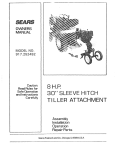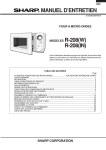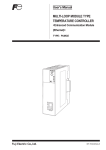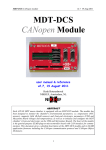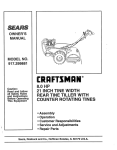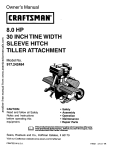Download Husqvarna TS200FR Tiller User Manual
Transcript
OWNER’S MANUAL TS 20 8 H.P. 30" (76,2 cm) SLEEVE HITCH TILLER ATTACHMENT MODEL NUMBER TS200FR 02480 169689 Rev. 2 4.11.03 TR Printed in U.S.A. SAFETY RULES Safe Operation Practices for Tiller Attachments. TRAINING • Read the operating and service instruction manual carefully. Be thoroughly familiar with the controls and the proper use of the equipment. Know how to stop the unit and disengage the controls quickly. • Never allow children to operate the equipment. Never allow adults to operate the equipment without proper instruction. • Keep the area of operation clear of all persons, par ticularly small children, and pets. PREPARATION • Thoroughly inspect the area where the equipment is to be used and remove all foreign objects. • Disengage all clutches and shift into neutral before starting the engine (motor). • Do not operate the equipment without wearing adequate outer garments. Wear footwear that will improve footing on slippery surfaces. • Handle fuel with care; it is highly flammable. • Use an approved fuel container. • Never add fuel to a running engine or hot engine. • Fill fuel tank outdoors with extreme care. Never fill fuel tank indoors. • Replace gasoline cap securely and clean up spilled fuel before restarting. • Never attempt to make any adjustments while the engine (motor) is running (except where specifically recommended by manufacturer). OPERATION • Do not put hands or feet near or under rotating parts. • Exercise extreme caution when operating on or crossing gravel drives, walks, or roads. Stay alert for hidden hazards or traffic. Do not carry passengers. • After striking a foreign object, stop the engine (motor), remove the wire from the spark plug, thoroughly inspect the tiller for any damage, and repair the damage before restarting and operating the tiller. • Exercise caution to avoid slipping or falling. • If the unit should start to vibrate abnormally, stop the engine (motor) and check immediately for the cause. Vibration is generally a warning of trouble. • Stop the engine (motor) when leaving the operating position, before unclogging the tines, and when making any repair, adjustments, and inspections. • Take all possible precautions when leaving the machine unattended. Disengage the power take-off, lower the attachment, shift into neutral, stop the engine, and remove the key. • Before cleaning, repairing, or inspecting, shut off the engine and make cer tain all moving parts have stopped. Disconnect the spark plug wire, and keep the wire away from the plug to prevent accidental starting. • Do not run the engine indoors; exhaust fumes are dangerous. • Never operate the tiller without proper guards, plates, or other safety protective devices in place. • Keep children and pets away. • Do not overload the machine capacity by attempting to till too deep at too fast a rate. • Never operate the machine at high speeds on slippery surfaces. Look behind and use care when backing. • Lift tiller out of the ground when turning corners. • Do not put tractor in reverse gear while tiller is in the ground. • Never allow bystanders near the unit. • Use only attachments and accessories approved by the manufacturer of the tiller (such as wheel weights, counterweights, cabs, etc. • Never operate the tiller without good visibility or light. MAINTENANCE AND STORAGE • Keep machine, attachments, and accessories in safe working condition. • Check shear bolts, engine mounting bolts, and other bolts at frequent intervals for proper tightness to be sure the equipment is in safe working condition. • Never store the machine with fuel in the fuel tank inside a building where ignition sources are present, such as hot water and space heaters, clothes dryers, etc. Allow the engine to cool before storing in any enclosure. • Always refer to the operator’s guide instructions for impor tant details if the tiller is to be stored for an extended period. -IMPORTANT Cautions, Importants, and Notes are a means of attracting attention to important or critical information in this manual. IMPORTANT: USED TO ALERT YOU THAT THERE IS A POSSIBILITY OF DAMAGING THIS EQUIPMENT. Caution: Look for this symbol to point out important safety precautions. It means -- Attention! Become Alert! Your safety is involved. NOTE: Gives essential information that will aid you to better understand, incorporate, or execute a particular set of instructions. 2 PRODUCT SPECIFICATIONS GASOLINE CAPACITY: CUSTOMER RESPONSIBILITIES • • 1 GALLON (3,6L) UNLEADED REGULAR OIL : SAE30W (ABOVE 32°F/0°C) (CAPACITY: 24 OZ. [0.7L]) 5W-30 (BELOW 32°F/0°C) TRANSMISSION OIL : SAE 30W • IMPORTANT: THIS UNIT IS EQUIPPED WITH AN INTERNAL COMBUSTION ENGINE AND SHOULD NOT BE USED ON OR NEAR ANY UNIMPROVED FOREST-COVERED, BRUSHCOVERED OR GRASS COVERED LAND UNLESS THE ENGINE'S EXHAUST SYSTEM IS EQUIPPED WITH A SPARK ARRESTER MEETING APPLICABLE LOCAL OR STATE LAWS (IF ANY). IF A SPARK ARRESTER IS USED, IT SHOULD BE MAINTAINED IN EFFECTIVE WORKING ORDER BY THE OPERATOR. (CAPACITY: 40 OZ. [1,2L]) SPARK PLUG : CHAMPION (GAP: .030" [0.76MM]) RJ19LM Read and observe the safety rules. Follow a regular schedule in maintaining, caring for and using your tiller attachment. Follow the instructions in the Customer Responsibilities and Storage sections of this Owner's Manual. CONGRATULATIONS on your purchase of a new Tiller Attachment. It has been designed, engineered and manufactured to give you the best possible dependability and performance. Should you experience any problems you cannot easily remedy, please contact your nearest authorized service facility, which has competent, well trained technicians and the proper tools to service or repair this unit. Please read and retain this manual. The instructions will enable you to assemble and maintain your tiller attachment properly. Always observe the "SAFETY RULES". TABLE OF CONTENTS SAFETY RULES ............................................................ 2 CUSTOMER RESPONSIBILITIES........................... 3,7-9 PRODUCT SPECIFICATIONS ....................................... 3 ASSEMBLY .................................................................... 4 OPERATION ............................................................... 5-6 SERVICE & ADJUSTMENTS ................................. 10-11 STORAGE .................................................................... 12 TROUBLESHOOTING ................................................. 13 REPAIR PARTS - TILLER ....................................... 14-17 3 ASSEMBLY • Adjust stabilizer bolts so that ends are about flush with rear of hitch bail (Fig. 2 - Inset). Leave nuts loose. • Lower hitch assembly and slide hitch yoke of tiller (Fig. 2 - Inset) over hitch tube of sleeve hitch so that the hitch pin holes line up. • Insert hitch pin until it extends from bottom of hitch yoke (Fig. 2 - Inset). Insert retainer spring into hitch pin. • Tighten both stabilizer bolts against the hitch yoke until there is no looseness at the hitch point. (The frame assembly does not swing sideways relative to the hitch bail (Fig. 2). Be sure the frame assembly is per pendicular (square) to the centerline (direction of travel) of the tractor. This can be determined by measuring the distance between the edge of tine shield (Fig. 2) and the back of the rear tires. This distance should be the same on the R.H. and L.H. sides within 1/2 inch. Securely tighten the nuts on the stabilizer bolts. NOTE: The stabilizer bolts should be loosened before removing the tiller from the tractor. This will make it easier to remove the hitch pin and to line up hitch pin holes when installing another attachment. If tractor is to be used without a rear attachment, the stabilizer bolt should be secured by tightening the nuts (Fig. 2-Inset). When R.H., (Right Hand) or L.H. (Left Hand) are used, it means from a position behind the steering wheel as If you were seated on the tractor seat and facing forward. NOTE: Remove mower deck from tractor before mounting tiller attachment. • Remove tiller and bag of parts from carton. Place tiller on level ground so that tractor can be backed up to it for assembly. CAUTION: Tiller will be heavy when performing the following step. Adjust tiller gauge wheels so that engine is level (Fig. 1). • Remove retainer spring from drilled rivet. • Remove rivet and adjust gauge wheels up or down as required to level tiller. Replace rivet and retainer spring. ATTACHING TILLER TO TRACTOR Optional accessory tractor weights and/or tire chains should be purchased to aid in the operation of this tiller attachment. • Install one or more wheel weights to each rear wheel to insure good traction when operating.Tire chains can be used in place of, or in addition to, wheel weights. FIG. 1 • • • Install two front end weights to the front of the tractor. This will aid steering control. Check tractor tires for proper air pressure. See your tractor's Owner's Manual. Assemble sleeve hitch to tractor. See hitch Owner's Manual. FIG. 2 4 OPERATION IMPORTANT: READ THE “RULES FOR SAFE OPERATION” CAREFULLY BEFORE OPERATING YOUR TILLER ATTACHMENT. CHECK ENGINE OIL LEVEL (See Fig. 1) The engine on your tiller has been shipped from the factory, already filled with summer weight oil. • Check engine oil with engine leveled on level ground. • Remove dipstick and wipe clean, replace, wait for a few seconds, remove and read oil level. If necessary, add oil until “FULL” mark on dipstick is reach. Do not overfill. • For cold weather operation you should change oil for easier starting (See “OIL VISCOSITY CHART” in the Customer Responsibilities section of this manual). • To change engine oil, see the Customer Responsibilities section in this manual. HOW TO USE YOUR TILLER STOPPING (See Fig. 3) TINES • Move tine clutch lever to “DISENGAGED” position. ENGINE • Move engine throttle lever to “STOP” position. • Never use choke to stop engine. TO USE CHOKE CONTROL (See Fig. 3-Inset) Use choke control whenever you are starting a cold engine. Do not use choke to start a warm engine. • To engage choke, slowly move lever to desired position. ADD GASOLINE • Fill fuel tank. Use fresh, clean, regular unleaded gasoline. (Use of leaded gasoline will increase carbon and lead oxide deposits and reduce valve life). IMPORTANT: WHEN OPERATING INTEMPERATURES BELOW 32°F (0°C), USE FRESH CLEAN WINTER GRADE GASOLINE TO HELP INSURE GOOD COLD WEATHER STARTING. TO ADJUST TILLING DEPTH (See Figs. 4 & 5) The tilling depth is controlled by the gauge wheels and to some extent by the adjustable link sleeve. When deeper tilling is required, the gauge wheels must be raised. Wheels must be lowered for shallower tilling, • Remove retainer spring from drilled rivet. Adjust gauge wheels up or down as desired and replace rivet and retainer spring. NOTE: Each hole will raise or lower gauge wheels 1 inch. • Tiller can be leveled from front to rear by turning adjustable link sleeve. The adjustable link sleeve also controls tilling depth. Shortening the adjustable link sleeve and lift links will decrease tilling depth and lengthening will increase tilling depth. TO OPERATE TILLER (See Fig. 3) • • • • • • • Select desired tilling depth. Raise tiller with tractor lift control and disengage tiller clutch control. Start tiller engine. See “BEFORE STARTING ENGINE” in this section of manual. Move tine clutch lever to “ENGAGED” position. Disengage and engage several times to check the clutching action of the belt. Slowly lower tiller with tractor lift control and begin tractor forward movement. Never operate tractor in reverse when tiller is in the ground. To stop tiller and engine, disengage tine clutch lever and move throttle lever to “STOP” position. BEFORE STARTING THE ENGINE CHECK TRANSMISSION OIL LEVEL (See Fig. 1) • • • The transmission has been filled at the factory. Check transmission oil with the tiller leveled on level ground. Remove oil fill plug. Oil should be level with the bottom of tiller plug hole. If necessary add oil until it is level with hole. 5 FIG. 3 OPERATION NOTE: If at a high altitude (Above 3000 feet) or in cold temperatures (below 32°F), the carburetor fuel mixture may need to be adjusted for best engine performance. See “TO ADJUST CARBURETOR” in the Service and Adjustments section of this manual. CAUTION: Fill to bottom of gas tank filler neck. Do not overfill. Wipe off any spilled oil or fuel. Do not store, spill or use gasoline near an open flame. WARNING: Experience indicates that alcohol blended fuels called gasohol or using ethanol or methanol) can attract moisture which leads to separation and formation of acids during storage. Acidic gas can damage the fuel system of an engine while in storage. To avoid engine problems, the fuel system should be emptied before storage of 30 days or longer. Drain the gas tank, start the engine and let it run until the fuel lines and carburetor are empty. Use fresh fuel next season. See Storage sections of this manual for additional information. Never use engine or carburetor cleaner products in the fuel tank or permanent damage may occur. TILLING The most efficient tillage is obtained when tiller engine is operated at full throttle. The sound of tiller engine will tell you when tiller engine is lightly loaded. Raise gauge wheels to increase tilling depth. If engine seems to be overloaded or stalls out, lower gauge wheels for shallower tilling. Operate tiller engine at full throttle and operate tractor in slowest forward speed, with tractor engine at idle speed or just above idle. You will soon learn the proper combination of tilling depth and speed for good tillage. Soil conditions will determine how deep tiller can penetrate on the first pass. In extremely hard ground, several passes may be necessary to till to a depth of 5 inches while in soft ground, tiller may penetrate to a depth of 5 inches in the first pass. TO START TILLER ENGINE (See Fig. 3) CAUTION: Keep the tine clutch lever in “DISENGAGED” position when starting engine. • • • • • • • • CULTIVATING Make sure spark plug wire is connected to spark plug. Move choke control lever to “FULL CHOKE” position for cold engine start. For warm engine start do not use choke control. Move tiller engine throttle to midway between “FAST” and “SLOW” positions. Grasp starter handle and pull rope out slowly until engine reaches start of compression cycle (rope will pull slightly harder at this point). Pull rope with a rapid, continuous, full arm stroke. Keep a firm grip on starter handle and let rope rewind slowly. Do not let starter handle snap back against starter. When engine starts, slowly move choke control on engine “1/2 CHOKE” position and then to “NO CHOKE” position as engine warms up. Move throttle control to desired running position. Allow engine to warm up for a few minutes before engaging tines. FIG. 4 Set gauge wheels so that tiller will penetrate soil to a depth of 2 to 3 inches. Place rivet in the second or third hole from the bottom to attain this depth. The tiller engine should be run at full throttle except when cultivating small plants, a slower engine speed is necessary to prevent burying the plants. OPERATION DO’S AND DON’TS Always disengage tine clutch lever (Fig. 3) and stop engine when traveling to or from field (garden) or when not tilling. Lift tiller out of the ground when turning corners. Do not put tractor in reverse gear while tiller is in the ground. Before leaving tractor seat, stop tractor, shift tractor to “NEUTRAL” position, throttle down and stop tractor engine, set parking brake, remove ignition key and then disengage tine clutch lever, throttle down and stop tiller engine, lower tiller to ground. Disconnect spark plug. Disconnect spark plug wires before making any adjustments, repairs or to remove debris in tines. 6 FIG. 5 MAINTENANCE SCHEDULE FILL IN DATES AS YOU COMPLETE REGULAR SERVICE BE FO RE EA FIR CH ST US 2H E EV OU ER RS Y5 HO EV ER UR Y2 S 5H EV OU ER RS Y5 0H EV OU ER RS Y1 00 BE HO FO UR RE S ST OR AG E CUSTOMER RESPONSIBILITIES SERVICE DATES Check Engine Oil Level Change Engine Oil Oil Pivot Points Inspect Spark Arrester / Muffler Inspect Air Screen Clean Air Filter/Foam Pre-Cleaner 2 Clean Engine Cylinder Fins Replace Air Filter/Paper Cartridge Replace Spark Plug 1 - Change more often when operating under a heavy load or in high ambient temperatures. 2 - Service more often when operating in dirty or dusty conditions. GENERAL RECOMMENDATIONS TILLER The warranty on this attachment does not cover items that have been subjected to operator abuse or negligence. To receive full value from the warranty, operator must maintain unit as instructed in this manual. Some adjustments will need to be made periodically to properly maintain your unit. All adjustments in the Service and Adjustments section of this manual should be checked at least once each season. • Once a year you should replace the spark plug, clean or replace air filter, and check tines and belts for wear. A new spark plug and clean air filter assure proper air-fuel mixture and help your engine run better and last longer. TRANSMISSION LUBRICATION (See Fig. 6) Check transmission oil level after first five (5) hours of operation and every ten (10) hours thereafter. • Check transmission oil with the tiller leveled on level ground. • Remove oil fill plug. Oil should be level with the bottom of filler plug hole. If necessary add SAE 30 motor oil or equivalent. SAE 5W-30 motor oil may be used in areas where temperature is consistently 32°F or lower. • Tighten oil fill plug securely each time you check the oil level. NOTE: It is not necessary to change the oil in tiller transmission. If for any reason, it must be changed, capacity is 1-1/4 quarts. BEFORE EACH USE • • • • Check engine oil level. Check brake operation. Check tire pressure. Check for loose fasteners. 7 CUSTOMER RESPONSIBILITIES TO CHANGE ENGINE OIL (See Figs. 6 and 7) Determine temperature range expected before oil change. All oil must meet API service classification SF or SG. • Be sure tiller engine is level. • Oil will drain more freely when warm. • Catch oil in a suitable container. • Remove drain plug. • Tip tiller forward to drain oil. • After oil has drained completely, replace oil drain plug and tighten securely. • Remove oil filler plug. Be careful not to allow dirt to enter the engine. • Refill engine with oil. See “CHECK ENGINE OIL LEVEL” in the Operation section of this manual. AIR FILTER FOAM PRE-CLEANER (See Fig. 8) Your engine will not run properly and may be damaged by using a dirty air filter. Remove cartridge every 25 hours and tap to clean. Replace paper cartridge once a year or after every 100 hours of operation, more often if used in very dusty, dirty conditions. • Remove wing nut and cover. • Remove foam pre-cleaner element by sliding it off of the paper cartridge. • Wash foam pre-cleaner in liquid detergent and water. • Wrap foam pre-cleaner in cloth and squeeze dry. • Lightly coat foam pre-cleaner with clean engine oil. Squeeze in towel to remove excess oil. Do not saturate. • Install foam pre-cleaner over paper cartridge. • Reassemble cover and tighten wing nut securely. FIG. 6 ENGINE LUBRICATION Use only high quality detergent oil rated with API service classification SF or SG. Select the oil’s SAE viscosity grade according to your expected temperature. SAE VISCOSITY GRADES SAE 30 5W-30 -20 F C -30 0 -20 30 -10 32 0 40 60 10 100 80 20 30 40 TEMPERATURE RANGE ANTICIPATED BEFORE NEXT OIL CHANGE oil_visc_chart1_e FIG. 7 NOTE: Although multi-viscosity oils (5W-30, 10W-30, etc.) improve starting in cold weather, these multi-viscosity oils will result in increased oil consumption when used above 32°F (0°C). Check your engine oil level more frequently to avoid possible engine damage from running low on oil. Change the oil after the first two hours of operation and every 25 hours thereafter or at least once a year if the tiller is not used for 25 hours in one year. Check the crankcase oil level before starting the engine and after each five (5) hours of continuous use. Add SAE 30 motor oil or equivalent. Tighten oil filler plug securely each time you check the oil level. FIG. 8 8 CUSTOMER RESPONSIBILITIES COOLING SYSTEM (See Fig. 9) Your engine is air cooled. For proper engine performance and long life keep your engine clean. • Clean air screen frequently using a stiff bristled brush. • Remove blower housing and clean as necessary. • Keep cylinder fins free of dirt and chaff. MUFFLER Do not operate tiller without muffler. Do not tamper with exhaust system. Damaged mufflers or spark arresters could create a fire hazard. Inspect periodically and replace if necessary. If your engine is equipped with a spark arrester screen assembly, remove every 50 hours for cleaning and inspection. Replace if damaged. SPARK PLUG Replace spark plugs at the beginning of each tilling season or after every 50 hours of use, whichever comes first. Spark plug type and gap setting is shown in “PRODUCT SPECIFICATIONS” on page 3 of this manual. CLEANING • Clean engine, wheels, finish, etc. of all foreign matter. • Keep finished surfaces and wheels free of all gasoline, oil, etc. • Protect painted surfaces with automotive type wax. We do not recommend using a garden hose to clean your unit unless the muffler, air filter and carburetor are covered to keep water out. Water in engine can result in a shortened engine life. FIG. 9 9 SERVICE AND ADJUSTMENTS CAUTION: Disconnect spark plug wires from spark plug and place wire where it cannot come into contact with plug. TILLER TO ADJUST GAUGE WHEELS See “TO ADJUST TILLING DEPTH” in Operation section of this manual. TO ADJUST BELT (See Fig. 10) The clutch is a belt-tightener type. Belt should be just tight enough to prevent slipping. Over-tightening will reduce belt life. • To tighten belt, remove retainer spring securing belt tightener link to clutch lever and arm. • Standing in front of tiller, turn link in a counterclockwise direction one turn at a time, until belt no longer slips. • After initial adjustment, a force of approximately 10 Ibs. at the end of the lever should engage the clutch. This would be heavy thumb pressure. TO REPLACE BELT (See Fig. 10) • Remove the three bolts holding belt guard to tiller. Remove guard. • Remove old belt. • Install new belt so that lower side of belt is above idler as shown. • Adjust belt (see “TO ADJUST BELT” above). • Replace belt guard. Make sure all moving parts will clear belt guard. NOTE: If it should become necessary to remove the engine sheave, be sure that it is reinstalled so that the set screw end is toward the outside. FIG. 10 10 SERVICE AND ADJUSTMENTS IDLE RPM ADJUSTMENT• With engine at idle speed, turn the idle adjust screw slowly counterclockwise until the engine begins to falter. • Then raise the engine speed by turning the idle adjust screw clockwise until the engine holds a smooth constant speed. ENGINE TO ADJUST CARBURETOR (See Fig. 11) The carburetor has been preset at the factory and adjustment should not be necessary. However, minor adjustments may be required to compensate for differences in fuel, temperature, altitude or load. If the carburetor does need adjustment, proceed as follows. In general, turning the adjust needles in (clockwise) decreases the supply of fuel to the engine giving a leaner fuel/air mixture. Turning the adjust needles out (counterclockwise) increases the supply of fuel to the engine giving a richer fuel/air mixture. ACCELERATION TEST • Move throttle control lever from “SLOW” to “FAST” position. If engine hesitates or dies, turn idle adjust needle out (counterclockwise) 1/8 turn. Repeat test and continue to adjust, if necessary, until engine accelerates smoothly. High speed stop is factory adjusted. Do not adjust or damage may result. IMPORTANT: DAMAGE TO THE NEEDLES AND THE SEATS IN CARBURETOR MAY RESULT IF SCREWS ARE TURNED IN TOO TIGHT. IMPORTANT: NEVER TAMPER WITH THE ENGINE GOVERNOR, WHICH IS FACTORY SET FOR PROPER ENGINE SPEED. OVER-SPEEDING THE ENGINE ABOVE THE FACTORY HIGH SPEED SETTING CAN BE DANGEROUS. IF YOU THINK THE ENGINE-GOVERNED HIGH SPEED NEEDS ADJUSTING, CONTACT YOUR NEAREST AUTHORIZED SERVICE CENTER, WHICH HAS PROPER EQUIPMENT AND EXPERIENCE TO MAKE ANY NECESSARY ADJUSTMENTS. PRELIMINARY SETTING • Air cleaner assembly must be assembled to the carburetor when making carburetor adjustments. • With engine off turn high speed adjust needle in (clockwise) closing it finger tight and then turn out (counterclockwise) 1-1/2 turns. • Turn idle adjust needle in (clockwise) closing it finger tight and then out (counterclockwise) 1-1/4 turns. FINAL SETTING • Start engine and allow to warm for five minutes. Make final adjustments with engine running and tine clutch control lever in “DISENGAGED” position. • With throttle control lever in “SLOW' position, turn idle adjust needle(clockwise) until engine begins to die then turn out (counterclockwise) until engine runs roughly. Turn needle to a point midway between those two positions. • With throttle control lever in “FAST” position, turn high speed adjust needle. FIG. 11 11 STORAGE Immediately prepare your tiller for storage at the end of the season or if the unit will not be used for 30 days or more. ENGINE OIL Drain oil (with engine warm) and replace with clean oil. (See “ENGINE” in the Customer Responsibilities section of this manual). CAUTION: Never store the tiller with gasoline in the tank inside a building where fumes may reach an open flame or spark. Allow the engine to cool before storing in any enclosure. CYLINDERS • • • TILLER • • • • • • Clean entire tiller (See “CLEANING” in the Customer Responsibilities section of this manual). Inspect and replace belts, if necessary (See belt replacement instructions in the Service and Adjustments section of this manual). Lubricate as shown in the Customer Responsibilities section of this manual. Be sure that all nuts, bolts and screws are securely fastened. Inspect moving parts for damage, breakage and wear. Replace if necessary. Touch up all rusted or chipped paint surfaces; sand lightly before painting. Remove spark plug. Pour 1 ounce (29 ml) of oil through spark plug hole into cylinder. Pull starter handle slowly several times to distribute oil. Replace with new spark plug. OTHER • • • • Do not store gasoline from one season to another. Replace your gasoline can if your can starts to rust. Rust and/or dirt in your gasoline will cause problems. If possible, store your unit indoors and cover it to give protection from dust and dirt. Cover your unit with a suitable protective cover that does not retain moisture. Do not use plastic. Plastic cannot breathe which allows condensation to form and will cause your unit to rust. IMPORTANT: NEVER COVER TILLER WHILE ENGINE AND EXHAUST AREAS ARE STILL WARM. ENGINE FUEL SYSTEM IMPORTANT: IT IS IMPORTANT TO PREVENT GUM DEPOSITS FROM FORMING IN ESSENTIAL FUEL SYSTEM PARTS SUCH AS THE CARBURETOR, FUEL FILTER, FUEL HOSE, OR TANK DURING STORAGE. ALSO, EXPERIENCE INDICATES THAT ALCOHOL BLENDED FUELS (CALLED GASOHOL OR USING ETHANOL OR METHANOL) CAN ATTRACT MOISTURE WHICH LEADS TO SEPARATION AND FORMATION OF ACIDS DURING STORAGE. ACIDIC GAS CAN DAMAGE THE FUEL SYSTEM OF AN ENGINE WHILE IN STORAGE. • • Drain the fuel tank. Start the engine and let it run until the fuel lines and carburetor are empty. • Never use engine or carburetor cleaner products in the fuel tank or permanent damage may occur. • Use fresh fuel next season. NOTE: Fuel stabilizer is an acceptable alternative in minimizing the formation of fuel gum deposits during storage. Add stabilizer to gasoline in fuel tank or storage container. Always follow the mix ratio found on stabilizer container. Run engine at least 10 minutes after adding stabilizer to allow the stabilizer to reach the carburetor. Do not drain the gas tank and carburetor if using fuel stabilizer. 12 TROUBLESHOOTING POINTS PROBLEM Will not start CAUSE CORRECTION 1. 2. 3. 4. 5. Out of fuel. Engine not “CHOKED” properly. Engine flooded. Dirty air cleaner. Water in fuel. 1. 2. 3. 4. 5. 6. 7. 8. 9. Clogged fuel tank. Loose spark plug wire. Bad spark plug or improper gap. Carburetor out of adjustment. 6. 7. 8. 9. Fill fuel tank. See “TO START ENGINE” in Operation section. Wait several minutes before attempting to start. Replace air cleaner cartridge. Drain fuel tank and carburetor, and refill tank with fresh gasoline. Remove fuel tank and clean. Make sure spark plug wire is seated properly on plug. Replace spark plug or adjust gap. Make necessary adjustments. Hard to start 1. 2. 3. 4. 5. 6. Throttle control not set properly. Dirty air cleaner. Bad spark plug or improper gap. Stale or dirty fuel. Loose spark plug wire. Carburetor out of adjustment. 1. 2. 3. 4. 5. 6. Place throttle control in “FAST” position. Replace air cleaner cartridge. Replace spark plug or adjust gap. Drain fuel tank and refill with fresh gasoline. Make sure spark plug wire is seated properly on plug. Make necessary adjustments. Loss of power 1. 2. 3. 4. 5. 6. 7. Engine is overloaded. Dirty air cleaner. Low oil level/dirty oil. Faulty spark plug. Oil in fuel. Stale or dirty fuel. Water in fuel. 1. 2. 3. 4. 5. 6. 7. Set depth stake for shallower tilling. Replace air cleaner cartridge. Check oil level/change oil. Clean and regap or change spark plug. Drain and clean fuel tank and refill, and clean carburetor. Drain fuel tank and refill with fresh gasoline. Drain fuel tank and carburetor, and refill tank with fresh gasoline. Remove fuel tank and clean. Connect and tighten spark plug wire. Clean engine air screen. Clean/replace muffler. Make necessary adjustments. Contact an authorized service facility. 8. 9. 10. 11. 12. 13. Clogged fuel tank. Spark plug wire loose. Dirty engine air screen. Dirty/clogged muffler. Carburetor out of adjustment. Poor compression. 8. 9. 10. 11. 12. 13. Engine overheats 1. 2. 3. 4. 5. Low oil level/dirty oil. Dirty engine air screen. Dirty engine. Partially plugged muffler. Improper carburetor adjustment. 1. 2. 3. 4. 5. Check oil level/change oil. Clean engine air screen. Clean cylinder fins, air screen, and muffler area. Remove and clean muffler. Adjust carburetor to richer position. Excessive bounce/ difficult handling 1. Ground too dry and hard. 1. Moisten ground or wait for more favorable soil conditions. Soil balls up or clumps 1. Ground too wet. 1. Wait for more favorable soil conditions. Engine runs but tiller tines won’t move 1. 2. 3. Tine clutch control is not engaged. V-belt not correctly adjusted. V-belt is off pulley(s). 1. 2. 3. Engage tine clutch control. Inspect/adjust V-belt. Inspect V-belt. Engine runs but labors 1. 2. Tilling too deep. Carburetor out of adjustment. 1. 2. Set gauge wheels for shallower tilling. Make necessary adjustments. 13 REPAIR PARTS 8 HP TILLER ATTACHMENT - - MODEL NUMBER TS200FR ENGINE AND TINES 14 REPAIR PARTS 8 HP TILLER ATTACHMENT - - MODEL NUMBER TS200FR ENGINE AND TINES KEY NO. PART DESCRIPTION KEY NO. NO. 1 2 3 4 5 6 7 8 9 10 11 12 13 14 15 124533X 6924J 677A860 4379H 677A855 6922R ------104867X 4914H 8249R 6652H 6656H 624A12 2360J 19151116 16 17 18 19 20 21 22 24 25 26 27 28 29 30 31 32 33 34 12000015 6683H 4933H 19131414 4497H 626A430 634A726 102655X 120076X 4929H 3146R 626A401 174043 71180512 626A402 8224R 76020516 8905R Control Throttle Bracket, Throttle Control Hitch Yoke Assembly Grip, Handle Hitch Channel Assembly Plate, Adapter Engine 8 H.P., Tecumseh Decal, Instruction, Engine Square Key 1/4 x 1-1/4 Engine Sheave Belt Tightener Link Adjusting Pin Idler Support Plate and Pivot Idler Arm Washer 15/32 x 11/16 x 16 Ga. (0 - 2 as required) * E-Ring E-Ring Idler Pulley Washer 13/32 x 7/8 x 14 Ga. Clip, Hairpin Lever and Arm Belt Guard and Supports V-Belt Decal, Caution Drilled Pan Hd. Rivet 3/8 x 1-3/4 Clip, Hairpin Tine Weldment, L.H. Decal, On/Off Screw, Fl. Hd. Mach. 5/16-24 Tine Weldment, R.H. Tine Shield Cotter Pin 5/32 x 1 Spring PART DESCRIPTION NO. 35 36 37 38 39 40 41 42 76020824 74760516 19131311 10040600 73220600 74760524 73220500 15760512 43 44 45 46 47 48 74760416 10040400 73220400 74770512 10040500 23200506 49 50 51 53 52 67 69 70 71 72 ----- 74760624 73750600 19111116 19121214 11050500 72250614 71191008 73731000 4171R 168461 110719X 104959X 169689 169690 Cotter Pin 1/4 x 1-1/2 * Bolt, Hex 5/16-18 x 1 Gr. 2 Washer 13/32 x 13/16 x 11 Ga. * Washer Lock, Hvy. Hel. Spring * Nut, Hex 3/8-16 UNC * Bolt, Hex 5/16-18 x 1-1/2 Gr. 2 * Nut, Hex 5/16-18 UNC Hex Bolt with Sems Ext. Washer Lock 5/16-18 UNC x 3/4 * Hex Bolt 1/4-20 x 1 * Washer Lock 1/4 * Hex Nut 1/4-20 UNC * Hex Bolt 5/16-24 x 3/4 * Washer Lock 5/16 Hex Socket Set Screw 5/16-18x3/8 * Hex Bolt 3/8-16 x 1-1/2 * Hex Lock Nut 3/8-16 UNC * Washer 11/32 x 11/16 x 16 Ga. Washer Washer Lock External Tooth 5/16 Bolt, Carriage 3/8-16 x 1-3/4 Screw Nut, Keps #10-24 UNC Clip - Insulated Decal, Throttle Decal, Oper./Lubrication (Engine) Decal, Tecumseh Logo (Engine) Owner’s Manual, English Owner's Manual, French *STANDARD HARDWARE--PURCHASE LOCALLY NOTE: All component dimensions given in U.S. inches. 1 inch = 25.4 mm. 15 REPAIR PARTS 8 HP TILLER ATTACHMENT - - MODEL NUMBER TS200FR TRANSMISSION AND GAUGE WHEELS 16 REPAIR PARTS 8 HP TILLER ATTACHMENT - - MODEL NUMBER TS200FR TRANSMISSION AND GAUGE WHEELS KEY NO. PART DESCRIPTION NO. 1 2 3 4 5 634A562 9135R 4929H 634A61 634A559 6 7 9 10 12 13 14 15 16 17 18 169374 4898H 73560600 5020J 4895H 9204 H 4932H 4910H 3039R 4877H1 634A553 19 20 21 24 26 27 28 29 30 31 32 33 34 35 36 37 2601R 4870H 634A555 2600R 1370H 4912H 634A59 634A58 9858M1 634A57 5855H 6672H 4913H 1685H 13060400 634A554 38 39 40 43 44 45 46 4878H1 10040600 73220600 7850H 19111116 74760636 17860524 48 49 74760532 20000524 50 51 74780596 15760512 * * * * * Transmission Retainer Spring Drilled Pan Head Rivet 3/8 x 1-3/4 Gauge Wheel Sleeve and Brackets Gauge Wheel Adjusting Shaft and Bracket Wheel Shoulder Bolt Locknut 3/8-16 UNC Nylock Needle Bearing Needle Bearing Locknut 1/2-20 UNF Input Sheave Oil Seal Needle Bearing Gear Case Shield L.H. Gear Case and Bearings L.H. Half (Inc. Key No's. 10,12,16 & 20) Gasket Thrust Cap Tine Shaft and Sprocket Roller Chain Thrust Washer Gasket 2nd Reduction Shaft and Gears 1st Reduction Shaft and Gears Woodruff Key 3/16 x 5/8 Input Shaft and Pinion Relief Valve Gear Shift Cover Gasket Locknut 5/16-18 UNC Pipe Plug 1/2-14 N.P.T. Gear Case and Bearings R.H. Half (Inc. Key No's. 12, 16 & 20) Gear Case Shield R.H. Washer Lock 3/8 Hex Nut 3/8-16 UNC Spacer Washer 11/32 x 11/16 x 16 Ga. Hex Bolt 3/8-16 x 2-1/4 Hex Hd. Roll-Lok Thd. Forming Screw 5/16-18 x 1-1/2 Hex Bolt 5/16-18 x 2 Flat Hd. Slotted Roll-Lok Thd. Forming Screws 5/16-18 x 3/4 Hex Bolt 5/16-18 x 6 Gr. 5 Screw Mach. Hex Hd. 5/16-18 x 3/4 *STANDARD HARDWARE--PURCHASE LOCALLY NOTE: All component dimensions given in U.S. inches. 1 inch = 25.4 mm. 17 02480


















